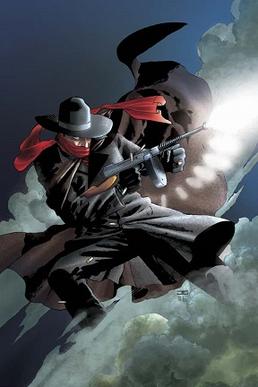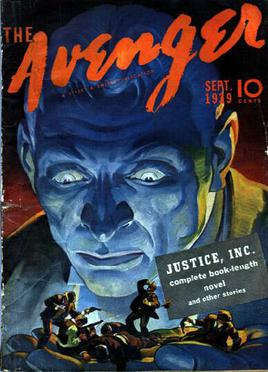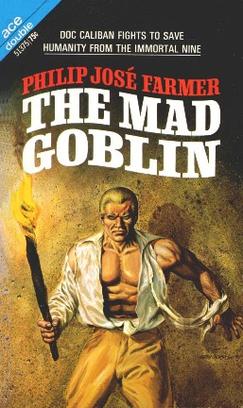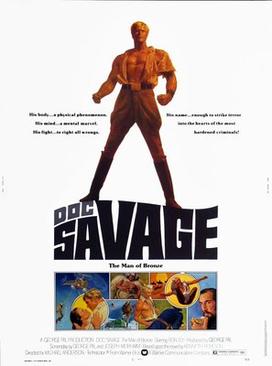Pulp magazines were inexpensive fiction magazines that were published from 1896 until around 1955. The term "pulp" derives from the cheap wood pulp paper on which the magazines were printed. In contrast, magazines printed on higher-quality paper were called "glossies" or "slicks". The typical pulp magazine had 128 pages; it was 7 inches (18 cm) wide by 10 inches (25 cm) high, and 0.5 inches (1.3 cm) thick, with ragged, untrimmed edges. Pulps were the successors to the penny dreadfuls, dime novels, and short-fiction magazines of the 19th century.
The Wold Newton family is a literary concept derived from a form of crossover fiction developed by the American science fiction writer Philip José Farmer.

Doc Savage is a fictional character of the competent man hero type, who first appeared in American pulp magazines during the 1930s and 1940s. Real name Clark Savage Jr., he is a polymathic scientist, explorer, detective, and warrior who "rights wrongs and punishes evildoers." He was created by publisher Henry W. Ralston and editor John L. Nanovic at Street & Smith Publications, with additional material contributed by the series' main writer, Lester Dent. Doc Savage stories were published under the Kenneth Robeson name. The illustrations were by Walter Baumhofer, Paul Orban, Emery Clarke, Modest Stein, and Robert G. Harris.

The Shadow is a fictional character created by American magazine publishers Street & Smith and writer Walter B. Gibson. Originally created to be a mysterious radio show narrator, and developed into a distinct literary character in 1931 by Gibson, The Shadow has been adapted into other forms of media, including American comic books, comic strips, serials, video games, and at least five feature films. The radio drama included episodes voiced by Orson Welles.

Lester Dent was an American pulp-fiction writer, best known as the creator and main writer of the series of novels about the scientist and adventurer Doc Savage. The 159 Doc Savage novels that Dent wrote over 16 years were credited to the house name Kenneth Robeson.

The Avenger is a fictional character whose original adventures appeared between September 1939 and September 1942 in the pulp magazine The Avenger, published by Street & Smith, which ran 24 issues. Five additional short stories were published in Clues Detective magazine (1942–1943), and a sixth novelette in The Shadow magazine in 1943. Decades later, newly written pastiches were commissioned and published by Warner Brothers' Paperback Library from 1973 to 1974.
G-8 was a heroic aviator and spy during World War I in pulp fiction. He starred in his own title G-8 and His Battle Aces, published by Popular Publications. All stories were written by Robert J. Hogan, under his own name. The title lasted 110 issues, from October 1933 to June 1944. Many of the novels have been reprinted by a wide range of publishers including comic books.

Tuned for Murder is the 9th pulp magazine story to feature The Avenger. Written by Paul Ernst, it was published in the May 1, 1940 issue of The Avenger magazine.
Lawrence Louis Donovan was an American pulp fiction writer who wrote nine Doc Savage novels under the pseudonym Kenneth Robeson, a pen name that was used by other writers of the same publishing house. However, there are nine Doc Savage novels duly credited to Donovan, published between November 1935 and July 1937.

Street & Smith or Street & Smith Publications, Inc., was a New York City publisher specializing in inexpensive paperbacks and magazines referred to as dime novels and pulp fiction. They also published comic books and sporting yearbooks. Among their many titles was the science fiction pulp magazine Astounding Stories, acquired from Clayton Magazines in 1933, and retained until 1961. Street & Smith was founded in 1855, and was bought out in 1959. The Street & Smith headquarters were at 79 Seventh Avenue in Manhattan; they were designed by Henry F. Kilburn.

The Mad Goblin is an American novel by Philip José Farmer. Originally released in 1970, it was one of two intertwining sequels to Farmer's previous A Feast Unknown, along with Lord of the Trees. The Mad Goblin features Doc Caliban, an analogue of Doc Savage, as the main character. The novel was later retitled Keepers of the Secrets.

Doc Savage: The Man of Bronze is a 1975 American action film starring Ron Ely as pulp hero Doc Savage. This was the last film completed by pioneering science fiction producer George Pal. It was directed by Michael Anderson, who had previously directed another big-budget adventure film, Around the World in 80 Days, the 1956 Best Picture of the Academy of Motion Picture Arts and Sciences.

William Murray is an American novelist, journalist, short story, and comic book writer. Much of his fiction has been published under pseudonyms. With artist Steve Ditko, he co-created the superhero Squirrel Girl.

East of Samarinda is a collection of stories by author Carl Jacobi. It was released in 1989 by Bowling Green State University Popular Press. Although Jacobi is known mostly for his horror and science fiction stories, this book collects adventure stories set in Borneo and the South Seas. The collection was edited by Carl Jacobi and R. Dixon Smith. Jacobi also provides a preface and Smith wrote the introduction.

Win Scott Eckert is an American author and editor, best known for his work on the literary-crossover Wold Newton Universe, created by author Philip José Farmer, but much expanded-upon subsequently by Eckert and others. He holds a B.A. in Anthropology and a Juris Doctor.
Stephen Gould Fisher was an American author best known for his pulp stories, novels and screenplays. He is one of the few pulp authors to go on to enjoy success as both an author in "slick" magazines, such as the Saturday Evening Post, and as an in-demand writer in Hollywood.

Doc Savage was an American pulp magazine that was published from 1933 to 1949 by Street & Smith. It was launched as a follow-up to the success of The Shadow, a magazine Street & Smith had started in 1931, based around a single character. Doc Savage's lead character, Clark Savage, was a scientist and adventurer, rather than purely a detective. Lester Dent was hired to write the lead novels, almost all of which were published under the house name "Kenneth Robeson". A few dozen novels were ghost-written by other writers, hired either by Dent or by Street & Smith. The magazine was successful, but was shut down in 1949 as part of Street & Smith's decision to abandon the pulp magazine field completely.










